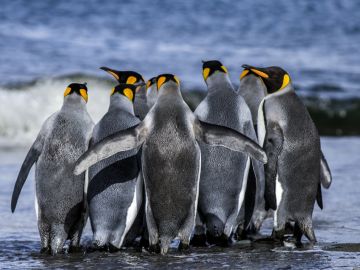There are over a dozen places around the world where you can see penguins in their natural habitat, but the penguins in Chile, which can be found throughout the southern coast and on the island of Tierra del Fuego, are among the world’s most accessible, plentiful (with over two million breeding pairs) and diverse.
You can find four different species of penguin here on the tip of South America, from the regal king penguins of Inútil Bay and the common Magellanic penguins to the diminutive Southern rockhopper penguins and the yellow-crested macaroni penguin. And each is a fascinating character in its own right, delighting animal lovers and wildlife photographers alike.
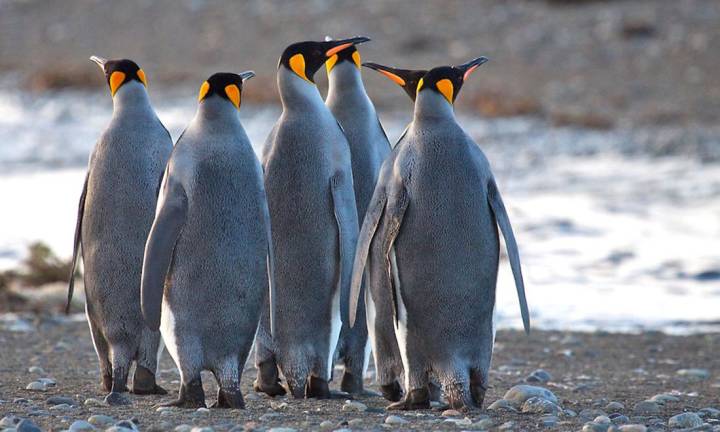
King Penguins
Second in size only to the emperor penguin, king penguins can grow over three feet in height and weigh up to 35 pounds.
With their regal stature, colorful yellow and orange chests, and propensity for forming massive breeding colonies of over 100,000 birds, they’ve become a flagship species for wildlife conservation. This despite the fact that, with a total population estimated at 2.3 million breeding pairs, the king penguin’s conservation status is listed by the International Union for the Conservation of Nature (IUCN) as “Least Concern.”
In addition to their size, another distinguishing characteristic of the king penguin is that they feed more on fish and squid and less on krill and other crustaceans. They’ve been recorded diving at depths of up to 1000 feet in their search for food, and spending around five minutes underwater on a single breath.
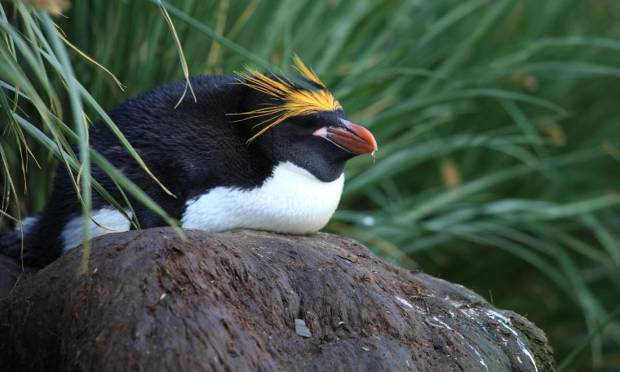
Macaroni Penguins
If you’ve ever heard the song “Yankee Doodle Dandy” and wondered about the origin of the line, “Stuck a feather in his cap and called it macaroni,” prepare to wonder no more! A macaroni was a pejorative term used in England in the mid-18th century to describe a man whose flamboyant approach to fashion bordered on the outlandish and comical. It’s a fitting name for one of the most colorful penguins on the planet.
One of six or so species collectively known as crested penguins, the macaroni penguin’s distinguishing characteristic is explained by the second word of its scientific name – Eudyptes chrysolophus – which translates to “golden crest.” The species boasts vivid orange and yellow crests that stretch horizontally from the center of its forehead to its nape, contrasting beautifully with its black head. Red eyes, beak and feet complete its colorful ensemble.
Typically numbering around 100,000, the macaroni breeding colonies are among the largest and densest of all penguin species. With a global population estimated at around 18 million, you’d think the species would be safe for the foreseeable future. But widespread population declines since the 1970s have caused the IUCN to list them as Vulnerable.
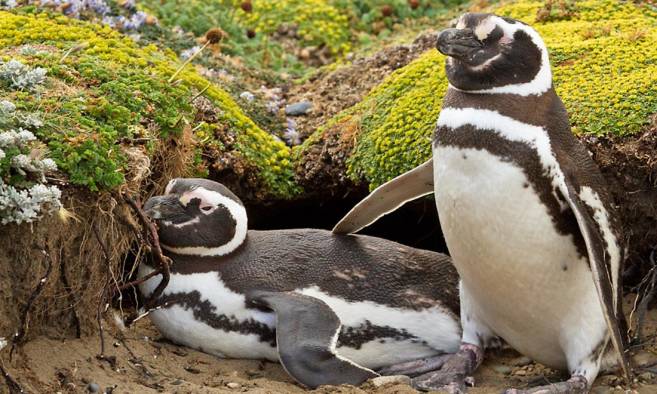
Magellanic Penguins
Named after Portuguese explorer Ferdinand Magellan (who first spotted the birds during his historic circumnavigation of the Earth in 1520), this is the most distinctively South American of all the penguin species.
In September, huge colonies of Magellanic penguins migrate south to the coasts of Patagonia, creating nests under bushes and in burrows on the sandy, rocky shores there. They mate with the same partner every year, and females can recognize their mate from his distinctive call. With incubation lasting around 40 days and chicks staying close for the first 30 days of their lives, the parents take turn standing watch while the other swims in search of food.
Currently listed as Near Threatened by the IUCN, Magellanic penguins have seen a steady decline in numbers over the last 20 years. Conservation challenges include climate change, which has displaced local fish populations and made it harder for the penguins to find food. As a result, more young penguins are moving north to be closer to their food source.
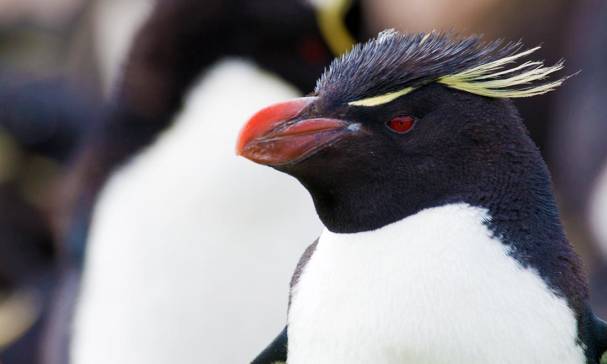
Southern Rockhopper Penguins
Technically two subspecies of rockhopper penguin (the South American Eudyptes chrysocome chrysocome and Eudyptes chrysocome filholi, which breeds in the Indian and western Pacific oceans), the southern rockhopper penguin could be the poster child for the phrase “odd bird.”
The smallest of the crested penguins, southern rockhoppers average about 20 inches in height and typically weigh just five-eight pounds. Their dark heads and red eyes are offset by bright yellow eyebrows that end in long plumes that jut out comically from the side of their faces. And then there’s their preferred mode of transport: As their name implies, southern rockhoppers are known for jumping over boulders and cracks rather than sliding on their bellies or using their flippers to climb awkwardly.
So perhaps it’s no coincidence that southern rockhoppers are a beloved staple of popular culture, from films (Surf’s Up, Happy Feet) and TV (3-2-1 Penguins!) to video games (Animal Crossing) and music (the rockhopper is Fleetwood Mac’s mascot). And with two-thirds of the global population of around one million breeding pairs found in South America, chances are good that you’ll see them in huge numbers when you visit southern Chile.
